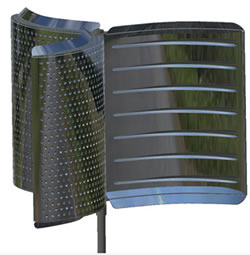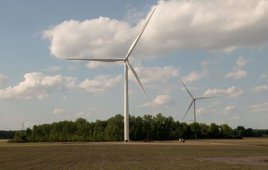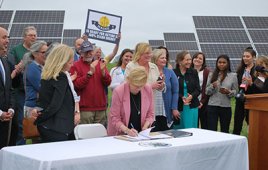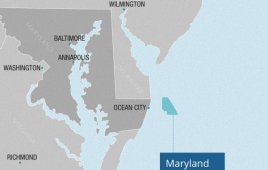
Air strakes (small wings) on the inside of each blade act like canals that capture and channel the air flow. The devices accelerate and direct the airflow through air jets onto the next blade. This action further assists in blade rotation. These design features, says the company, let the unit turn in low-speed wind and provide high-torque conversions with predictable results
The wind power market has been dominated by large horizontal wind turbines that compromise the ability of many companies to take advantage of wind power at their buildings or plants. This is due to the economics of horizontal wind turbines that favor large units and current technology dynamics.
A new design for a drag-propulsion device is said to let its rim speed exceed that of a similarly sized horizontal-axis wind turbine (HAWT). The unconventional drag-propulsion design, uses concave and convex surfaces to continually divert wind mass to turbine blades. Force is applied to the turbine blades both entering and leaving the rotors for maximum energy extraction.
A Grumman Aerospace paper on the subject suggests that the theoretical increase in power of drag-propulsion over lift-propulsion can be thousands of times greater. (A Tornado-like Wind Energy System, by James T. Yen / Research Department, Grumman Aerospace Corporation, Published IECEC).
Engineers at Sauer Energy Inc., believe a vertical axis wind turbine has advantages over the more traditional horizontal axis designs when it comes to uneven wind conditions where HAWT has to change directions and speed. This puts stress on the bearings and tower, and dissipates useful energy. Gravitational stresses on the VAWT, however, are more evenly distirbuted, allowing lighter and larger construction. The VAWT has blades in a configuration that uses the mass momentum of the wind to spin and capture around a central mass. Force is applied to the blades by the wind both entering and leaving the turbine, allowing maximum effectiveness of energy.
Sauer engineers say their vertical-axis wind turbine addresses many of the technology’s shortcomings, such as noise, minimum blade speed threshold, bird endangerment, and space limitations, while enhancing its advantages. The proposed compact vertical-axis design can be sited without being intrusive and mounts onto buildings of most any size.
Better yet, says the company, simpler installations and rebates shorten the unit’s ROI. Power generated offsite, such as at wind farms, is subject to transmission and distribution charges. Onsite generation take a portion of the organizational power requirements “off the grid.”
Sauer engineers add that a traditional horizontal blade design turbine of similar size requires a greater level of wind speed to generate power. Vertical axis turbines provide omni-directional wind collection. The torque produced lets it make power while turning at slower blade speeds. For instance, it only takes a 6-mph wind to turn the blade, says the developer. That means the unit can work at locations with lower average wind speeds. Therefore, the geographic option for using wind energy is greatly expanded; a company may not need to be located on a hilltop or in coastal locations to reap the benefits. Plus, it reduces wind direction limitations, because it can collect wind power on a 360° basis.
A prototype model is aerodynamically engineered for the maximum effects. Its most notable features are the air disruptors, which cause a turbulent boundary layer to form, thus reducing drag and creating a faster rotational speed. The multi-patented design allows using state-of-the-art materials, such as carbon fiber composites, to make it lightweight and durable. The turbine is said to assemble easily with few tools. The company offers few other details.
Sauer Energy
Filed Under: Uncategorized




